|
 Suillus subacerbus Suillus subacerbus
BiostatusPresent in region - Exotic
Images (click to enlarge)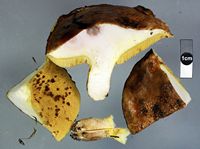
Caption: flesh shows fading pink of KOH & NH4OH
Owner: J.A. Cooper | 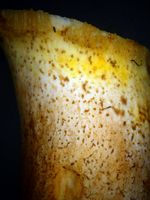
Caption: stem apex showing glandulae
Owner: J.A. Cooper | 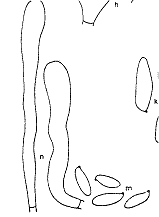
Caption: Suillus subacerbus: m, spores; n, cystidia. | 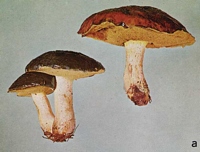
Caption: Fig. 7 - a, Suillus subacerbus (x 1/2) | 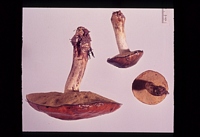
Caption: C-3575
Owner: Herb. PDD | 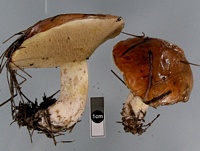
Owner: J.A. Cooper | 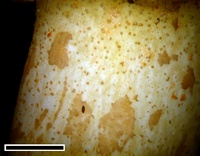
Caption: scale=5mm. Glandular dots on stem apex.
Owner: J.A. Cooper | 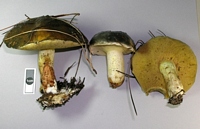
Owner: J.A. Cooper | 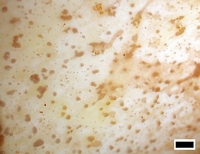
Caption: Glandulae on stem apex. Scale = 1mm
Owner: J.A. Cooper | 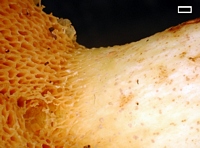
Caption: step apex and pores. Scale = 1mm
Owner: J.A. Cooper | 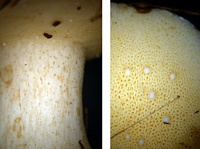
Caption: stem and milk on pores.
Owner: J.A. Cooper | 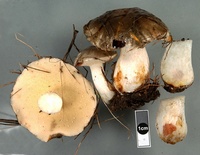
Caption: not red/brown with KOH
Owner: J.A. Cooper | 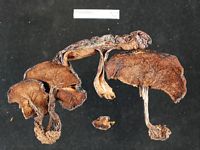
Caption: Dried type specimen
Owner: Herb PDD |
Article: McNabb, R.F.R. (1968). The Boletaceae of New Zealand. New Zealand Journal of Botany 6(2): 137-176 (http://www.rsnz.org/publish/abstracts.php).
Description: PILEUS: plano-convex
to applanate, 7-14 cm diam., mucilaginous, glabrous, extremely variable in colour,
often pallid creamy yellow to olive grey when young, becoming yellow ochre,
yellow, cinnamon brown, cocoa brown or reddish orange at maturity, more often
irregularly streaked or patched with a mixture of several of these colours,
occasionally entirely greyish; cuticle an ixotrichodermium, to 300 µm. thick,
readily separable, composed of more or less erect, interwoven, hyaline hyphae
2.5-3.5 µm diam., heavily gelatinised and crystal-encrusted, hypodermium well
differentiated, both cuticle and hypodermium staining vinaceous with KOH; margin
entire, often undulate, extending beyond pores, inrolled, sterile. HYMENOPHORE:
tubes to 12mm long, adnate to sub-decurrent, dull yellow when young, becoming
darker at maturity; pores concolorous with tubes, angular, 0.75-1 mm diam.,
unchanging where damaged, beaded with droplets of cloudy, white liquid when
young. STIPE: 5-8-(11) cm long, more or less equal, or slightly expanded basally,
2-2.5 cm diam., solid, often faintly reticulate apically, white at first, becoming
pallid creamy white to creamy yellow, glandulae irregular in size and shape,
often large and conspicuous, greyish to pinkish when young, pinkish brown at
maturity; flesh white, staining bright yellow when exposed to air; annulus absent.
SPORES: spore print yellowish brown (between Cinnamon
and Clay Color); spores pallid melleous, elliptic-subfusiform to oblong-elliptical,
7.8-9.1-(9.8) X 3.0-3.6-(3.9) µm, smooth. HYMENIUM: basidia hyaline, clavate,
21-30 X 5-7.5 µm., 4-spored; cystidia crowded in groups at or near tube mouths,
no solitary cystidia seen, thin-walled, subclavate to clavate, 35-70 X 5.5-8.5
µm., vinaceous in KOH. HYMENOPHORAL TRAMA: bilateral of the Boletus subtype;
clamp connections absent. CONTEXT OF PILEUS: white to pallid yellow, usually
with large brownish areas, unchanging on exposure to air. TASTE: mild. SMELL:
not distinctive. CHEMICAL REACTIONS: KOH on pileus—dark brown with vinaceous
tints; on context of pileus—immediate, red flush turning mauve; NH4OH on pileus—dark
reddish brown; on 'context— faint red to mauve.
Habitat: HABITAT: Gregarious or caespitose under Pinus.
Notes: Suillus subacerbus is probably of North American origin. In New Zealand it has been found
only in association with Pinus radiata.
Suillus subacerbus appears to belong to the S. granulatus - S. pungens -S.
acerbus complex of species as described by Smith and Thiers (1964) in their
extensive study of North American Suilli. Of these species, S. subacerbus
is most closely related to S. pungens Thiers & A. H. Smith and S.
acerbus A. H. Smith & Thiers, both of which are recently described species
naturally associated with Pinus radiata in California. However, it differs
from both these species in a number of characters. In pileus colour, Suillus
subacerbus most closely resembles S. pungens, but differs in the
absence of a marginal roll of white tissue when young, shorter spores, vinaceous
colour produced by KOH on cuticle and cystidia, and absence of a harsh taste
and strong pungent smell. It is perhaps more closely related to S. acerbus,
from which it may be separated by the combination of colours in the pileus,
smaller spores, constant vinaceous colour produced by KOH on cuticle and cystidia,
and absence of an unpleasant taste. Although these may appear to be but minor
differences, the distinctions between many species of Suillus are not
great, and S. subacerbus cannot satisfactorily be accommodated within
any of the species so far described.
S. subacerbus may be distinguished from other Suilli occurring in New Zealand by the combination
of colours in the pileus, presence of glandulae, absence of an annulus, and
vinaceous colour reaction to KOH.
Article: Gadgil, P.D. (in association with Dick, M.A.; Hood, I.A.; Pennycook, S.R.) (2005). Fungi on trees and shrubs in New Zealand. Fungi of New Zealand. Ngā Harore o Aotearoa 4: xi + 437 p. Hong Kong: Fungal Diversity Press.
Description: Type: Mycorrhizal Fungi; Description: Basidiomata pileate. Pileus variable in colour, creamy yellow to olive grey when young, becoming yellow, cinnamon brown or reddish orange later, often streaked with a mixture of these colours, 70–140 mm in diameter, plano-convex to applanate, mucilaginous; flesh white to pale yellow. Pore surface adnate to subdecurrent; tubes dull yellow becoming darker, up to 12 mm long; pores concolorous with tubes, angular, 0.7–1 mm in diameter. Stipe more or less cylindrical, white at first but becoming creamy yellow, with conspicuous greyish to pinkish brown glandulae, annulus absent, 50–80 mm long. Basidiospores elliptical, 0-septate, 8–10 × 3–4 μm, smooth, pale yellow.
Distribution: Distribution: Auckland.; 1st Record: McNabb (1968).
|